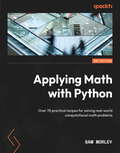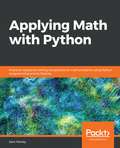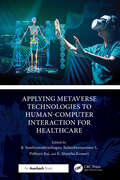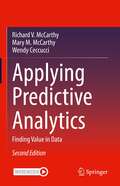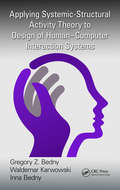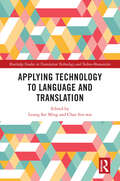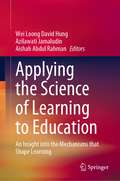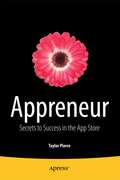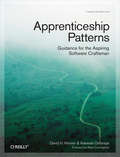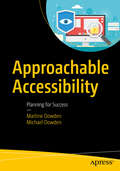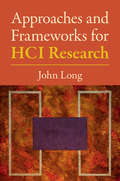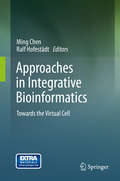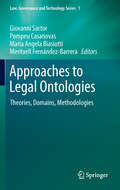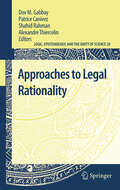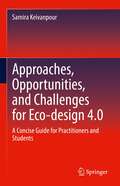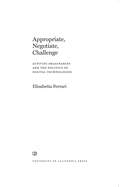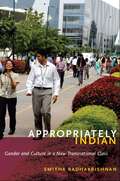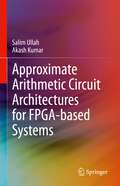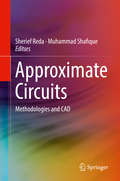- Table View
- List View
Applying Machine Learning in Science Education Research: When, How, and Why? (Springer Texts in Education)
by Peter Wulff Marcus Kubsch Christina KristThis open access textbook offers science education researchers a hands-on guide for learning, critically examining, and integrating machine learning (ML) methods into their science education research projects. These methods power many artificial intelligence (AI)-based technologies and are widely adopted in science education research. ML can expand the methodological toolkit of science education researchers and provide novel opportunities to gain insights on science-related learning and teaching processes, however, applying ML poses novel challenges and is not suitable for every research context. The volume first introduces the theoretical underpinnings of ML methods and their connections to methodological commitments in science education research. It then presents exemplar case studies of ML uses in both formal and informal science education settings. These case studies include open-source data, executable programming code, and explanations of the methodological criteria and commitments guiding ML use in each case. The textbook concludes with a discussion of opportunities and potential future directions for ML in science education. This textbook is a valuable resource for science education lecturers, researchers, under-graduate, graduate and postgraduate students seeking new ways to apply ML in their work.
Applying Math with Python: Over 70 practical recipes for solving real-world computational math problems, 2nd Edition
by Sam MorleyDiscover easy-to-follow solutions and techniques to help you to implement applied mathematical concepts such as probability, calculus, and equations using Python's numeric and scientific librariesKey FeaturesCompute complex mathematical problems using programming logic with the help of step-by-step recipesLearn how to use Python libraries for computation, mathematical modeling, and statisticsDiscover simple yet effective techniques for solving mathematical equations and apply them in real-world statisticsBook DescriptionThe updated edition of Applying Math with Python will help you solve complex problems in a wide variety of mathematical fields in simple and efficient ways. Old recipes have been revised for new libraries and several recipes have been added to demonstrate new tools such as JAX.You'll start by refreshing your knowledge of several core mathematical fields and learn about packages covered in Python's scientific stack, including NumPy, SciPy, and Matplotlib. As you progress, you'll gradually get to grips with more advanced topics of calculus, probability, and networks (graph theory). Once you've developed a solid base in these topics, you'll have the confidence to set out on math adventures with Python as you explore Python's applications in data science and statistics, forecasting, geometry, and optimization. The final chapters will take you through a collection of miscellaneous problems, including working with specific data formats and accelerating code.By the end of this book, you'll have an arsenal of practical coding solutions that can be used and modified to solve a wide range of practical problems in computational mathematics and data science.What you will learnBecome familiar with basic Python packages, tools, and libraries for solving mathematical problemsExplore real-world applications of mathematics to reduce a problem in optimizationUnderstand the core concepts of applied mathematics and their application in computer scienceFind out how to choose the most suitable package, tool, or technique to solve a problemImplement basic mathematical plotting, change plot styles, and add labels to plots using MatplotlibGet to grips with probability theory with the Bayesian inference and Markov Chain Monte Carlo (MCMC) methodsWho this book is forWhether you are a professional programmer or a student looking to solve mathematical problems computationally using Python, this is the book for you. Advanced mathematics proficiency is not a prerequisite, but basic knowledge of mathematics will help you to get the most out of this Python math book. Familiarity with the concepts of data structures in Python is assumed.
Applying Math with Python: Practical recipes for solving computational math problems using Python programming and its libraries
by Sam MorleyThis book is for professional programmers and students looking to solve mathematical problems computationally using Python. Advanced mathematics knowledge is not a requirement, but a basic knowledge of mathematics will help you to get the most out of this book. The book assumes familiarity with Python concepts of data structures.
Applying Metaverse Technologies to Human-Computer Interaction for Healthcare
by Pethuru Raj Balasubramaniam S K. Shantha KumariThe concept of the metaverse signifies the forthcoming stage of development of the Internet, wherein it will facilitate the creation of virtual worlds that are enduring, decentralized, and capable of providing immersive experiences in real time. The metaverse has vast potential for utilization in the domains of life sciences and healthcare, hence motivating investigations in contemporary trends, early adoption use cases, and the forthcoming opportunities it presents. The metaverse also possesses the capacity to fundamentally transform decentralized clinical trials through the elimination of physical and geographical constraints. This change in thinking entails the relocation of clinical trials from conventional settings to the comfort and convenience of patients’ residences, resulting in improvements in health behavior, medication adherence, remote monitoring, and other associated factors.Applying Metaverse Technologies to Human-Computer Interaction for Healthcare focuses on the current developments in the metaverse, investigates its applications in the life sciences and healthcare industry based on metaverse powered human−computer interactions (HCI), analyzes early adoption use cases that provide measurable commercial benefits, and anticipates prospects in this rapidly evolving domain.The book examines the treatment, management, and prevention of illnesses with the use of immersive therapeutics that use augmented reality (AR), virtual reality (VR), and mixed reality (MR). It examines applications in cognitive therapy, support groups, psychiatric examinations, rehabilitation, and even physical therapy The book covers how healthcare practitioners have the capability to provide such services as diagnosis, treatment, monitoring, and care in remote settings, through the utilization of AR headsets and wearable devices. It concludes by discussing the continuous development of technology to facilitate the growth and maturation of the metaverse, hence enabling substantial business benefits for the life sciences and healthcare industries.
Applying Predictive Analytics: Finding Value in Data
by Richard V. McCarthy Mary M. McCarthy Wendy CeccucciThe new edition of this textbook presents a practical, updated approach to predictive analytics for classroom learning. The authors focus on using analytics to solve business problems and compares several different modeling techniques, all explained from examples using the SAS Enterprise Miner software. The authors demystify complex algorithms to show how they can be utilized and explained within the context of enhancing business opportunities. Each chapter includes an opening vignette that provides real-life examples of how business analytics have been used in various aspects of organizations to solve issues or improve their results. A running case provides an example of a how to build and analyze a complex analytics model and utilize it to predict future outcomes. The new edition includes chapters on clusters and associations and text mining to support predictive models. An additional case is also included that can be used with each chapter or as a semester project.
Applying Quantitative Bias Analysis to Epidemiologic Data (Statistics for Biology and Health)
by Matthew P. Fox Timothy L. Lash Aliza K. FinkThis text provides the first-ever compilation of bias analysis methods for use with epidemiologic data. It guides the reader through the planning stages of bias analysis, including the design of validation studies and the collection of validity data from other sources. Three chapters present methods for corrections to address selection bias, uncontrolled confounding, and classification errors. Subsequent chapters extend these methods to multidimensional bias analysis, probabilistic bias analysis, and multiple bias analysis. The text concludes with a chapter on presentation and interpretation of bias analysis results. Although techniques for bias analysis have been available for decades, these methods are considered difficult to implement. This text not only gathers the methods into one cohesive and organized presentation, it also explains the methods in a consistent fashion and provides customizable spreadsheets to implement the solutions. By downloading the spreadsheets (available at links provided in the text), readers can follow the examples in the text and then modify the spreadsheet to complete their own bias analyses. Readers without experience using quantitative bias analysis will be able to design, implement, and understand bias analyses that address the major threats to the validity of epidemiologic research. More experienced analysts will value the compilation of bias analysis methods and links to software tools that facilitate their projects.
Applying Systemic-Structural Activity Theory to Design of Human-Computer Interaction Systems (Ergonomics Design & Mgmt. Theory & Applications)
by Waldemar Karwowski Gregory Z. Bedny Inna BednyHuman Computer Interaction (HCI) is no longer limited to trained software users. Today people interact with various devices such as mobile phones, tablets, and laptops. How can such interaction be made more user friendly, even when user proficiency levels vary? This book explores methods for assessing the psychological complexity of compute
Applying Technology to Language and Translation (Routledge Studies in Translation Technology)
by Leung Sze Ming and Chan Sin-waiA cutting-edge collection of work on the influence and application of new technologies on the study and practice of language and translation. This book analyzes the relationship between technology, language, and translation in the digital age. Language issues covered include an automatic football commentary system, the use of digital humanities in the versification of Classical Chinese poetry, the application of corpus linguistics in identity construction in Hong Kong, Cantonese speech recognition, and the use of AI in a Chabot system. Other chapters look at translation matters, such as technologies for interpreting, neural machine translation for press releases, computer-aided annotation for translator and interpreter training, and artificial intelligence and translation. As language and translation are closely intertwined, together, these chapters illustrate the drastic changes that technology has brought to these combined areas. A vital resource for scholars and students studying the impact of technology on language and translation.
Applying and Extending Oracle Spatial
by Siva Ravada Simon GreenerThis book is an advanced practical guide to applying and extending Oracle Spatial.This book is for existing users of Oracle and Oracle Spatial who have, at a minimum, basic operational experience of using Oracle or an equivalent database. Advanced skills are not required.
Applying the Science of Learning to Education: An Insight into the Mechanisms that Shape Learning
by Azilawati Jamaludin Wei Loong David Hung Aishah Abdul RahmanThis book provides an overview of the various 'Science of Learning' (SoL) research projects led by researchers at the National Institute of Education, Nanyang Technological University, Singapore, and international research collaborators. It presents the goals and rationale behind the Science of Learning in Education (SoLE) initiative and examines a spectrum of topics relevant to bolstering our understanding of the science underlying learning. The Science of Learning (SoL) is an advancing field, with proponents extolling its potential impact on educational practice. This book investigates the possible correlations or causal relationships between brain functioning and development, physiology, environment factors, and their impact on learning. It promotes an interdisciplinary approach to understanding biological to behavioural mechanisms of learning that are oriented toward optimizing and maximizing every learner’s potential.
Appreciation Post: Towards an Art History of Instagram
by Tara WardWhat does an art history of Instagram look like? Appreciation Post reveals how Instagram shifts long-established ways of interacting with images. Tara Ward argues Instagram is a structure of the visual, which includes not just the process of looking, but what can be seen and by whom. She examines features of Instagram use, including the effect of scrolling through images on a phone, the skill involved in taking an "Instagram-worthy" picture, and the desires created by following influencers, to explain how the constraints imposed by Instagram limit the selves that can be displayed on it. The proliferation of technical knowledge, especially among younger women, revitalizes on Instagram the myth of the masculine genius and a corresponding reinvigoration of a masculine audience for art. Ward prompts scholars of art history, gender studies, and media studies to attend to Instagram as a site of visual expression and social consequence. Through its insightful comparative analysis and acute close reading, Appreciation Post argues for art history’s value in understanding the contemporary world and the visual nature of identity today.
Appreneur: Secrets to Success in the App Store
by Taylor PierceYou are interested in making an app. You have read all of the stories of successful developers and appreneurs. You are determined to get a piece of the pie. The world of apps is the fastest growing market in the world today, and it is here to stay. The best part is you can get in on it! Now what if I told you that without the knowledge contained in this book the odds of you making a profit are slim to none? What if I also told you that you probably wouldn't break even? There is more to apps than most people think. The average person assumes that if they make an app, they will instantly become a millionaire. The truth is without the knowledge from years of successes and failures, you just won't know where to begin. Appreneur book contains tips, tricks, secrets, and stories from the top developers, appreneurs, and companies from around the globe. After reading this book, you will have the knowledge to bring your idea to life, market it, promote it, and sell it in a way that would have otherwise been impossible. What you'll learn How to start at the bottom and rise to the top How to choose the right development and platform for you How to create a market for yourself instead of playing the competition How to generate revenue from various app business models available How to figure out what's hot versus what's not How to make the most of your advertising dollars What is free to pay (F2P) model and how to take advantage of it How to secure your rights and later sell your rights to cash out or "hit it big" How to evolve with the app stores and keep piracy to a minimum Who this book is for This book is for aspiring indie mobile app developers, especially those who want to build and sell apps on Apple iTunes App Store. Table of Contents Starting at the Bottom and Rising to the Top Choosing the Right Development Option for You Don't Compete in a Market; Create it Generating Revenue from Various Business Models Managing Users for Today for Success Tomorrow What's Hot and What's Not Making the Most of your Advertising Money Plan to Scale or Your App Will Fail Life Cycles of Apps Selling The Rights and Cashing Out Keeping Piracy to a Minimum Evolving with the App Store Appendix: Guest Chapter by Appversal
Apprenez à programmer par vous-même
by Zach ZinfadelCe livre ne vous apprendra pas seulement la programmation, car il couvre aussi des sujets que d’autres cours ou livres n’enseignent pas. Il vous fournira des instructions spécifiques ainsi que des bribes de code faciles à comprendre qui vous montreront comment programmer correctement. Il comprend notamment : — des tutoriels de programmation en HTML et en Javascript ; — une introduction à la programmation et au codage ; — une explication sur les variables et la façon de les utiliser ; — tout ce qui concerne les tableaux et les structures logiques ; — comment écrire votre premier programme.
Apprenticeship Patterns: Guidance for the Aspiring Software Craftsman
by Dave Hoover Adewale OshineyeAre you doing all you can to further your career as a software developer? With today's rapidly changing and ever-expanding technologies, being successful requires more than technical expertise. To grow professionally, you also need soft skills and effective learning techniques. Honing those skills is what this book is all about. Authors Dave Hoover and Adewale Oshineye have cataloged dozens of behavior patterns to help you perfect essential aspects of your craft.Compiled from years of research, many interviews, and feedback from O'Reilly's online forum, these patterns address difficult situations that programmers, administrators, and DBAs face every day. And it's not just about financial success. Apprenticeship Patterns also approaches software development as a means to personal fulfillment. Discover how this book can help you make the best of both your life and your career. Solutions to some common obstacles that this book explores in-depth include: Burned out at work? "Nurture Your Passion" by finding a pet project to rediscover the joy of problem solving.Feeling overwhelmed by new information? Re-explore familiar territory by building something you've built before, then use "Retreat into Competence" to move forward again.Stuck in your learning? Seek a team of experienced and talented developers with whom you can "Be the Worst" for a while."Brilliant stuff! Reading this book was like being in a time machine that pulled me back to those key learning moments in my career as a professional software developer and, instead of having to learn best practices the hard way, I had a guru sitting on my shoulder guiding me every step towards master craftsmanship. I'll certainly be recommending this book to clients. I wish I had this book 14 years ago!"-Russ Miles, CEO, OpenCredo
Approachable Accessibility: Planning for Success
by Martine Dowden Michael DowdenUnderstand the realities of modern web accessibility and what considerations should be made to include everyone. There are hundreds of millions of people who are being left out every single day on the web due to disability or circumstance. The purpose of web accessibility is to remove barriers and bring the information, services, and functionality of the web to as many people as possible so they can be included in this global community. This book makes the topic of web accessibility as approachable as possible to help every web professional become an accessibility advocate at their companies, on their projects, and in their communities. This discussion will go beyond the buzzword to explore the impact our designs and decisions have on real people, along with the ethical, legal, and financial incentives for accessibility prioritization. For those who are ready to get started the book covers tools and techniques for testing websites or web applications for conformance to the Web Content Accessibility Guidelines. Because we very rarely work in a vacuum the book also covers how to educate your team or company management on web accessibility as well as persuading them to invest time and money in accessibility. For those looking to start an accessibility practice at their company – or simply to ensure that nothing slips through the cracks – the book includes a guide to creating your very own accessibility action plan. Having a well-documented plan of action is an essential step in the long-term success of any initiative. Get started with web accessibility using Approachable Accessibility today. What You'll LearnDiscover various ways that website design can exclude or even harm usersGain an understanding of the Web Content Accessibility Guidelines (WCAG) 2.1Put together an accessibility action plan for your organizationExplore tools and techniques for evaluating your existing websites Who This Book Is For Web designers and developers who want to know more about web accessibility or just want to know how to get started; tech leaders who need help building an accessibility practice or convincing their company to invest in web accessibility; project managers and owners making scope decisions for a project.
Approaches and Frameworks for HCI Research
by John LongThis research textbook, designed for young Human-Computer Interaction (HCI) researchers beginning their careers, surveys the research models and methods in use today and offers a general framework to bring together the disparate concepts. HCI spans many disciplines and professions, including information science, applied psychology, computer science, informatics, software engineering and social science making it difficult for newcomers to get a good overview of the field and the available approaches. The book's rigorous 'approach-and-framework' response is to the challenge of retaining growth and diversification in HCI research by building up a general framework from approaches for Innovation, Art, Craft, Applied, Science and Engineering. This general framework is compared with other HCI frameworks and theories for completeness and coherence, all within a historical perspective of dissemination success. Readers can use this as a model to design and assess their own research frameworks and theories against those reported in the literature.
Approaches in Integrative Bioinformatics: Towards the Virtual Cell
by Ming Chen Ralf HofestädtApproaches in Integrative Bioinformatics provides a basic introduction to biological information systems, as well as guidance for the computational analysis of systems biology. This book also covers a range of issues and methods that reveal the multitude of omics data integration types and the relevance that integrative bioinformatics has today. Topics include biological data integration and manipulation, modeling and simulation of metabolic networks, transcriptomics and phenomics, and virtual cell approaches, as well as a number of applications of network biology. It helps to illustrate the value of integrative bioinformatics approaches to the life sciences. This book is intended for researchers and graduate students in the field of Bioinformatics. Professor Ming Chen is the Director of the Bioinformatics Laboratory at the College of Life Sciences, Zhejiang University, Hangzhou, China. Professor Ralf Hofestädt is the Chair of the Department of Bioinformatics and Medical Informatics, Bielefeld University, Germany.
Approaches to Legal Ontologies: Theories, Domains, Methodologies (Law, Governance and Technology Series #1)
by Giovanni Sartor Mariangela Biasiotti Meritxell Fernández-Barrera Pompeu CasanovasThe book provides the reader with a unique source regarding the current theoretical landscape in legal ontology engineering as well as on foreseeable future trends for the definition of conceptual structures to enhance the automatic processing and retrieval of legal information in the Semantic Web framework. It will thus interest researchers in the domains of the SW, legal informatics, Artificial Intelligence and law, legal theory and legal philosophy, as well as developers of e-government applications based on the intelligent management of legal or public information to provide both back-office and front-office support.
Approaches to Legal Rationality (Logic, Epistemology, and the Unity of Science #20)
by Dov M. Gabbay Patrice Canivez Shahid Rahman Alexandre ThiercelinLegal theory, political sciences, sociology, philosophy, logic, artificial intelligence: there are many approaches to legal argumentation. Each of them provides specific insights into highly complex phenomena. Different disciplines, but also different traditions in disciplines (e.g. analytical and continental traditions in philosophy) find here a rare occasion to meet. The present book contains contributions, both historical and thematic, from leading researchers in several of the most important approaches to legal rationality. One of the main issues is the relation between logic and law: the way logic is actually used in law, but also the way logic can make law explicit. An outstanding group of philosophers, logicians and jurists try to meet this issue. The book is more than a collection of papers. However different their respective conceptual tools may be, the authors share a common conception: legal argumentation is a specific argumentation context.
Approaches, Opportunities, and Challenges for Eco-design 4.0: A Concise Guide for Practitioners and Students
by Samira KeivanpourThis book addresses the implications of the Industry 4.0 paradigm in design for the environment. We examine the opportunities for, and challenges of, the implications of cyber-physical systems, big data analytics, Internet of things, additive manufacturing, and simulation in a range of areas in an eco-design context. These include selecting low impact materials, choosing manufacturing processes with environmental considerations, end of life strategies, applying design approaches for disassembly, integrating economic and social components into environmental studies, and stakeholder’s involvement. This volume takes a step toward this journey to explore how the three pillars of technology, sustainability, and evolving consumers could shape the future of the product’s design.
Appropriate, Negotiate, Challenge: Activist Imaginaries and the Politics of Digital Technologies
by Dr. Elisabetta FerrariActivists use digital technologies to communicate, coordinate, and organize for social change. But these big corporate digital platforms are also used to spread disinformation, racism, and abuse. Appropriate, Negotiate, Challenge investigates the relationship between activism and technology, focusing on how activists think and talk about technology’s role in social change and what this tells us about the politics of digital technologies. Researching movements in Italy, Hungary, and the United States, Elisabetta Ferrari examines how leftist activists construct technological imaginaries that appropriate, negotiate, and challenge Silicon Valley’s vision of technology. She argues that these imaginaries reflect and shape the politics of social movements: they matter for how activists think about their political possibilities. Ultimately, Ferrari centers the political and imaginative work that activists need to perform in order to navigate the politics of mainstream digital technologies.
Appropriately Indian: Gender and Culture in a New Transnational Class
by Smitha RadhakrishnanAppropriately Indian is an ethnographic analysis of the class of information technology professionals at the symbolic helm of globalizing India. Comprising a small but prestigious segment of India's labor force, these transnational knowledge workers dominate the country's economic and cultural scene, as do their notions of what it means to be Indian. Drawing on the stories of Indian professionals in Mumbai, Bangalore, Silicon Valley, and South Africa, Smitha Radhakrishnan explains how these high-tech workers create a "global Indianness" by transforming the diversity of Indian cultural practices into a generic, mobile set of "Indian" norms. Female information technology professionals are particularly influential. By reconfiguring notions of respectable femininity and the "good" Indian family, they are reshaping ideas about what it means to be Indian. Radhakrishnan explains how this transnational class creates an Indian culture that is self-consciously distinct from Western culture, yet compatible with Western cosmopolitan lifestyles. She describes the material and symbolic privileges that accrue to India's high-tech workers, who often claim ordinary middle-class backgrounds, but are overwhelmingly urban and upper caste. They are also distinctly apolitical and individualistic. Members of this elite class practice a decontextualized version of Hinduism, and they absorb the ideas and values that circulate through both Indian and non-Indian multinational corporations. Ultimately, though, global Indianness is rooted and configured in the gendered sphere of home and family.
Approximate Arithmetic Circuit Architectures for FPGA-based Systems
by Akash Kumar Salim UllahThis book presents various novel architectures for FPGA-optimized accurate and approximate operators, their detailed accuracy and performance analysis, various techniques to model the behavior of approximate operators, and thorough application-level analysis to evaluate the impact of approximations on the final output quality and performance metrics. As multiplication is one of the most commonly used and computationally expensive operations in various error-resilient applications such as digital signal and image processing and machine learning algorithms, this book particularly focuses on this operation. The book starts by elaborating on the various sources of error resilience and opportunities available for approximations on various layers of the computation stack. It then provides a detailed description of the state-of-the-art approximate computing-related works and highlights their limitations.
Approximate Circuits: Methodologies and CAD
by Muhammad Shafique Sherief RedaThis book provides readers with a comprehensive, state-of-the-art overview of approximate computing, enabling the design trade-off of accuracy for achieving better power/performance efficiencies, through the simplification of underlying computing resources. The authors describe in detail various efforts to generate approximate hardware systems, while still providing an overview of support techniques at other computing layers. The book is organized by techniques for various hardware components, from basic building blocks to general circuits and systems.
Approximate Iterative Algorithms
by Anthony Louis AlmudevarIterative algorithms often rely on approximate evaluation techniques, which may include statistical estimation, computer simulation or functional approximation. This volume presents methods for the study of approximate iterative algorithms, providing tools for the derivation of error bounds and convergence rates, and for the optimal design of such

